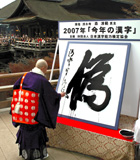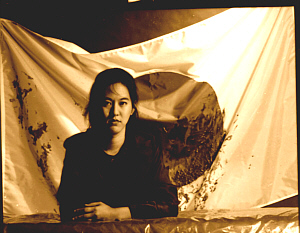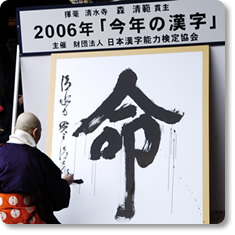Kanji of the Year 2007 – Fake
Seihan Mori, the chief priest of Kiyomizudera temple in Kyoto, writes the kanji “nise” which means “disguise” or “fake,” on paper screen Wednesday. The Chinese character was chosen as most suitable in describing the year in Japan, which has been marked by scandals involving food mislabeling, missing pension records and falsified political fund reports, among other things. (Asahi)

90,816 people voted by internet, postcard and by attending the temple in person, and the top kanji chosen by them was 偽, nise, gi, meaning imitation, deception, or bogus. This year has been full of such stories; it started off with fake health benefits from natto, and continued with one scandal after another, from construction companies faking earthquake resistance to beef-free beef croquettes. This leads us to the number two choice, 食, shoku, food, where in addition to the ironically-named Meat Hope beef mentioned before, trusted souvenir brands Akafuku and Shiroi Koibito amongst others got caught reusing ingredients that had passed their expiry dates. To round out the bad news, third was 嘘, uso, lies, which claimed the life of one politician this year.
Inochi – life
These pessimistic characters are a marked contrast from the last two years; 2006 was 命, inochi, life, and 2005 was 愛, ai, love. (Via)
Japan in denial – The Fake of Nanking Massacre (read Iris Chang)
Filmanthropy, “Nanking” is recently released.
Filmmaker’s Scott Macaulay points to a couple of pieces by Leonis that address the concept of “filmanthropy.” It was Chang’s suicide in 2005, at the age of 36, that inspired Leonis to fund Nanking, Michelle Orange reminds us. (via)
Iris Chang (Image source)
(Image source)
See also previous post –
Kanji of the Year 2004, Wazawai -meaning disaster
